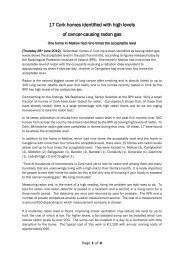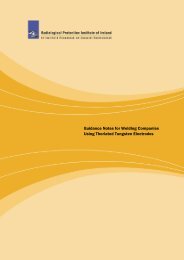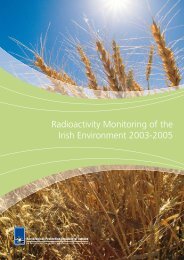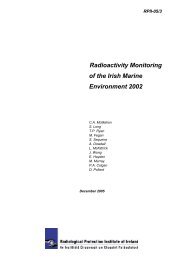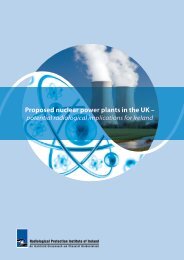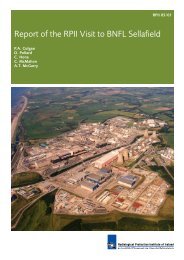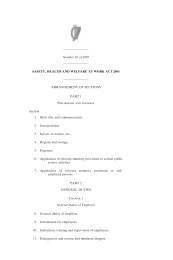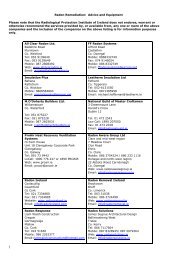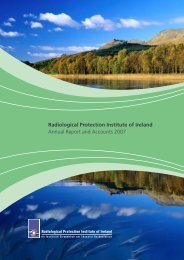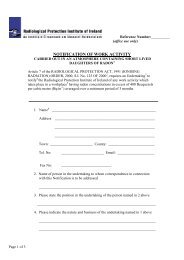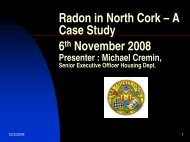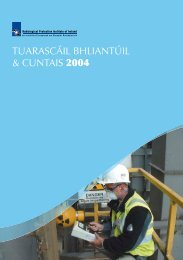Cork - Radiological Protection Institute of Ireland
Cork - Radiological Protection Institute of Ireland
Cork - Radiological Protection Institute of Ireland
Create successful ePaper yourself
Turn your PDF publications into a flip-book with our unique Google optimized e-Paper software.
One in ten homes tested in <strong>Cork</strong> found with high levels <strong>of</strong> cancercausing<br />
radon gas<br />
[Friday 27 th January 2012]. Eleven per cent <strong>of</strong> <strong>Cork</strong> homes recently tested for radon were found<br />
to have high levels <strong>of</strong> the cancer-causing gas according to figures released today by the<br />
<strong>Radiological</strong> <strong>Protection</strong> <strong>Institute</strong> <strong>of</strong> <strong>Ireland</strong> (RPII).<br />
Over 300 homes from across the country have been identified by the RPII as having high levels <strong>of</strong><br />
radon in the last seven months. Nationally, radon is the second biggest cause <strong>of</strong> lung cancer<br />
after smoking and is directly linked to up to 200 lung cancer deaths each year.<br />
In <strong>Cork</strong>, 205 tests for radon gas were completed in homes between 1 st June 2011 and 31 st<br />
December 2011. Of these, 22 were above the acceptable level <strong>of</strong> 200 becquerels per cubic<br />
metre (Bq/m 3 ).<br />
One home in Douglas had more than three times the acceptable level with a reading in excess <strong>of</strong><br />
600 Bq/m 3 . The remaining 21 homes had readings above the acceptable level and were found<br />
in: Mallow (7), Carrigaline (2), Carrigtwohill (1) Ballyhooly, (1), Ballyphilip (1), Bandon (1),<br />
Castlelyons (1), Clonakilty (1), Crosshaven (1), Curraheen (1), Doneraile (1), Kildorrery (1),<br />
Newmarket (1) and Whitechurch (1).<br />
Commenting on the findings Mr David Fenton, Senior Scientist at the RPII said: “These figures<br />
show that <strong>Cork</strong> has a significant radon problem. Our research indicates there are hundreds more<br />
homes across the county with high levels <strong>of</strong> radon gas. To date, only a very small proportion <strong>of</strong><br />
these homes have been identified. Exposure to high radon levels causes lung cancer and many<br />
people are unknowingly living with very high levels in their homes. The only way people will know<br />
if it is in their homes is by testing.”<br />
Measuring for radon and, in the event <strong>of</strong> a high reading, reducing the levels present are both<br />
easy to do. To test for radon, one radon detector is placed in a bedroom and a second in a living<br />
room for a three-month period. The detectors are sent and returned by post for analysis. The<br />
RPII and a number <strong>of</strong> private companies provide a radon measurement service. The cost <strong>of</strong> a<br />
measurement is around €50.<br />
If a moderate radon level is found, improving indoor ventilation may reduce the level by up to<br />
half, the cost <strong>of</strong> which is low. For higher levels, a fan assisted sump can be installed which can<br />
reduce radon levels by over 90%. The sump can be installed in a day by a contractor with little<br />
disruption to the home. The average cost <strong>of</strong> this work is €1,100 with annual running costs <strong>of</strong><br />
approximately €90.<br />
An interactive map is available on the RPII’s website (www.rpii.ie) so that anyone can search for<br />
their address or nearest town to see whether their home or workplace is in a High Radon Area.<br />
They can find out what they need to know about radon – what it is, why it is a problem and how<br />
they can have a measurement made. Information can also be obtained by phoning Freefone<br />
1800 300 600.<br />
ENDS<br />
Page 1 <strong>of</strong> 3
For further information:<br />
<strong>Radiological</strong> <strong>Protection</strong> <strong>Institute</strong> <strong>of</strong> <strong>Ireland</strong><br />
David Dawson 01 206 69 13<br />
Marie Kelly 01 269 77 66<br />
Murray Consultants 01 498 03 00<br />
Aoibheann O’Sullivan 087 629 14 53<br />
Note to Editors:<br />
In the interest <strong>of</strong> confidentiality, the identification and exact location <strong>of</strong> the homes with high<br />
radon results will not be made available.<br />
Over the last two years the RPII conducted comprehensive public information campaigns on the<br />
risks from radon in Counties Sligo, Carlow, Waterford, South Tipperary and Galway.<br />
Data for all radon measurements undertaken since the early 1990s to-date by the RPII is<br />
available on its website: http://www.rpii.ie/Your-Home/Radon-in-your-home/Radon-results-bycountry.aspx<br />
Radon is a naturally occurring radioactive gas that originates from the decay <strong>of</strong> uranium in rocks<br />
and soils. It has no smell, colour or taste and can only be detected using special detectors.<br />
Outdoors, radon quickly dilutes to harmless concentrations but when it enters an enclosed<br />
space, such as a house or other building, it can accumulate to unacceptably high concentrations.<br />
This gives rise to a radiation dose, which may cause lung cancer.<br />
The national Reference Level for radon in homes is 200 becquerels per cubic metre (Bq/m 3 ). The<br />
becquerel is the unit <strong>of</strong> radioactivity.<br />
Radon is a Class-1 carcinogen. Long-term exposure to radon increases the risk <strong>of</strong> lung cancer.<br />
Based on current knowledge, it is estimated that in <strong>Ireland</strong>, for the population as a whole, a<br />
lifetime exposure (i.e. 70 years) to radon in the home at the Reference Level <strong>of</strong> 200 Bq/m 3<br />
carries a risk <strong>of</strong> about 1 in 50 <strong>of</strong> contracting fatal lung cancer. This is approximately twice the risk<br />
<strong>of</strong> death in a road accident. For people who smoke, or who have smoked, the risk from radon is<br />
up to 25 times greater than for people who never smoked.<br />
Specific guidance on radon prevention measures for new homes is contained the “Building<br />
Regulations 1997, Technical Guidance Document C – site preparation and resistance to<br />
moisture” which is published by The Department <strong>of</strong> Environment, Community and Local<br />
Government<br />
(http://www.environ.ie/en/Publications/DevelopmentandHousing/BuildingStandards/FileDownL<br />
oad,1642,en.pdf). The guidance specifies that all new homes, built since 1st July 1998, must be<br />
fitted with a standby radon sump which can be activated at a later stage to reduce any high<br />
radon concentrations subsequently found. For homes built in High Radon Areas, the installation<br />
<strong>of</strong> a radon barrier as well as a standby radon sump is required.<br />
Page 2 <strong>of</strong> 3
Results <strong>of</strong> radon tests undertaken by the RPII between 1 st June 2011 and 31 st December 2011<br />
showing the county, category <strong>of</strong> radon concentration, maximum level found and location <strong>of</strong> find.<br />
County<br />
Total<br />
number <strong>of</strong><br />
houses<br />
measured<br />
Number <strong>of</strong> houses in categories <strong>of</strong> radon<br />
concentration<br />
0-199<br />
Bq/m 3<br />
200-799<br />
Bq/m 3<br />
800–1999<br />
Bq/m 3<br />
>2000<br />
Bq/m 3<br />
Maximum<br />
(Bq/m 3 )<br />
Location<br />
Carlow 42 31 10 1 1000 Borris<br />
Cavan 7 7<br />
Clare 367 345 20 2 1200 Newmarket On Fergus<br />
<strong>Cork</strong> 205 183 22 600 Douglas<br />
Donegal 54 49 4 1 1000 Ballyshannon<br />
Dublin 178 171 7 700 Dalkey<br />
Galway 200 154 39 6 1 3700 Castlegar<br />
Kerry 140 112 22 4 2 2500 Tralee<br />
Kildare 47 47<br />
Kilkenny 68 56 12 500 Kilkenny<br />
Laois 12 12<br />
Leitrim 15 14 1 200 Manorhamilton<br />
Limerick 50 49 1 500 Newcastle West<br />
Longford 8 6 2 300 Edgeworthstown<br />
Louth 29 27 2 400 Dundalk<br />
Mayo 149 126 22 1 1000 Ballina<br />
Meath 31 30 1 200 Navan<br />
Monaghan 11 11<br />
Offaly 10 10<br />
Roscommon 28 28<br />
Sligo 67 53 12 1 1 2700 Tubbercurry<br />
Tipperary 502 448 53 1 800 Clonmel<br />
Waterford 202 160 36 6 1200 Dungarvan<br />
Westmeath 18 17 1 200 Mullingar<br />
Wexford 74 58 15 1 1800 Enniscorthy<br />
Wicklow 82 71 11 600 Enniskerry<br />
Total 2596 2275 293 24 4<br />
The column headed Maximum (Bq/m 3 ) is rounded down to the nearest 100<br />
Page 3 <strong>of</strong> 3



